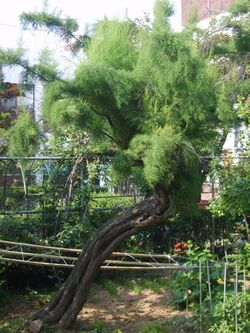Biology:Tamarix chinensis
| Tamarix chinensis | |
|---|---|

| |
| Scientific classification | |
| Kingdom: | Plantae |
| Clade: | Tracheophytes |
| Clade: | Angiosperms |
| Clade: | Eudicots |
| Order: | Caryophyllales |
| Family: | Tamaricaceae |
| Genus: | Tamarix |
| Species: | T. chinensis
|
| Binomial name | |
| Tamarix chinensis Lour.
| |
| Synonyms | |
| |
Tamarix chinensis is a species of tamarisk known by the common names five-stamen tamarisk[1] and Chinese tamarisk[2] or saltcedar. It is native to China and Korea, and it is known in many other parts of the world as an introduced species and sometimes an invasive noxious weed. It easily inhabits moist habitat with saline soils. It may grow as a tree with a single trunk or as a shrub with several spreading erect branches reaching 6 metres or more in maximum height. It has been known to reach 12 metres.[3] It has reddish, brown, or black bark. The small, multibranched twigs are covered in small lance-shaped, scale-like leaves which are no more than about 3 mm long. The inflorescence is a dense raceme of flowers a few cm long. Each fragrant flower has five petals which are usually pink but range from white to red.
This tamarisk can hybridize with Tamarix parviflora.[3] T. ramosissima may be treated in synonymy or as a separate species.
It has become an aggressive invader of wildlands in the southwestern United States, where it was once planted as an ornamental plant.[3] It reproduces vegetatively from its roots and also from its foliage if it happens to be covered by soil, as in sediment-rich flooding.[3] It also reproduces by its seed, which are tiny and tufted with hairs, easily dispersing on the wind.[3] Despite its reputation as a noxious weed, the tree can be useful for wood, in honey production, and as a nesting site for various birds.[3]
In its native habitat in China the plant forms thickets that act as useful barriers on the margins of waterways, including saline ocean shores.[4]
References
- ↑ "Tamarix chinensis". Natural Resources Conservation Service PLANTS Database. USDA. https://plants.usda.gov/core/profile?symbol=TACH2. Retrieved 8 December 2015.
- ↑ (xls) BSBI List 2007, Botanical Society of Britain and Ireland, https://bsbi.org/download/3542/, retrieved 2014-10-17
- ↑ 3.0 3.1 3.2 3.3 3.4 3.5 Sheppard, W. D. (2008). Tamarix chinensis. In: Bonner, F. T., et al. The Woody Plant Seed Manual. Agric. Handbook No. 727. Washington, DC. USDA, Forest Service. p. 1087-1088.
- ↑ Cui, B. (2010). "Responses of saltcedar (Tamarix chinensis) to water table depth and soil salinity in the Yellow River Delta, China". Plant Ecology 209 (2): 279–290. doi:10.1007/s11258-010-9723-z.
External links
| Wikimedia Commons has media related to Tamarix chinensis. |
- Jepson Manual Treatment
- {{citation
| mode = cs1 | title = Tamarix chinensis | work = Germplasm Resources Information Network (GRIN) | url = | publisher = [[Organization:Agricultural Research ServAgricultural Research Service (ARS), United States Department of Agriculture (USDA) | access-date = }}
Wikidata ☰ Q6825364 entry
 |

